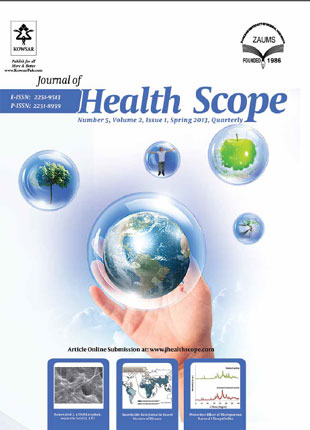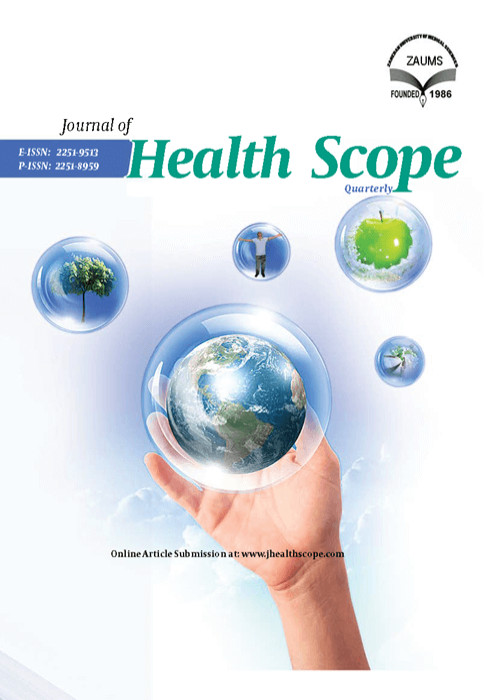فهرست مطالب

Journal of Health Scope
Volume:2 Issue: 1, Spring 2013
- تاریخ انتشار: 1392/03/03
- تعداد عناوین: 10
-
-
Page 4Context: Arthropod-borne diseases are remaining as a major public health issue in the resource-constrained settings. Mosquitoes are closely associated with mankind since time immemorial and play an important role in the transmission of many dreadful diseases like malaria, filariasis, Japanese encephalitis, dengue and yellow fever. Over the decades, vector control is an important element to minimize the vector-borne disease burden worldwide and in fact, it heavily relies upon synthetic insecticides as a mainstay. However the overuse and misuse of insecticides have led to the emergence of resistance, which undermines the potentiality of vector control. Evidence Acquisition: In order to pursue effective research pertained to this issue, a detailed search on Scopus, Medline, Google Scholar and academic premier databases has been conducted between the time periods of 1955 and 2012.ResultsOver the past six decades, insecticides are serving as one of the important arsenals in the fight against vector-borne diseases to save hundreds of millions of lives. Consequently, in the last decade we have attained a remarkable success to combat with many diseases particularly malaria due to the combined effect of indoor residual spraying (IRS) and long-lasting insecticidal nets (LLINs). Currently, malaria mortality rates have drastically fallen by more than 25% globally, 33% in sub-Saharan Africa and over a million lives have been saved attributable tomassive scale-up of LLINs and IRS. Since, both LLINs and IRS are cost-effectiveand robust form of interventions; they are serving as a central pillar in the National Malaria Control Programmes (NMCPs) of malaria endemic countries. Nevertheless, LLINs are easy-to-deliver, most economical and practical even in the resource-poor settings, where implementation of IRS is not feasible. The heavy reliance, recurrent and inappropriate insecticide applications are key sources for resistance which is a potential threat to the global public health. Therefore, it has to be addressed immediately to sustain the recent success of vector control, unless otherwise it would become uncertain.ConclusionsThough, development of resistance is an evolutionary phenomenon, it can be tackled judiciously by implementing appropriate and comprehensive resistance monitoring and management strategies within the framework of integrated vector management. This scrutiny recommends the following measures; (i) identification of effective novel tools for monitoring and evaluation, (ii) searching for alternative interventions to minimize the further resistance evolution as well as to preserve the efficiency of existing insecticides, (iii) exploration of next generation vector control tools in terms of nets and new classes of non-pyrethroid insecticide formulation with new mode of action, (iv) building partnership by bringing together the people actively engaged in the vector control, like public health experts, policy-makers, researchers, medical entomologists and insecticide manufacturers, could ideally pave the way to collectively address the current debacle in the near future.Keywords: Pest Control, Disease Vectors, Mosquito Control, Insecticide Resistance
-
Page 19BackgroundDiarrhea infection has been established as one of the major etiologies and risk factors of malnutrition in children..ObjectivesThe aim of this study was to assess the maternal knowledge, attitude and practices when treating diarrhea in their children less than 5 years old in the Zahedan, south-east province of Iran..Materials And MethodsThis cross-sectional study was conducted in urban health centers in Zahedan. Three hundred mothers who had less than five years old children and had been referred to the health centers for six months duration had been included. The questions were about demographic characteristics, knowledge and practice regarding childhood diarrhea, and had been designed to obtain information through an interview..ResultsThe findings indicated that knowledge of the majority of mothers (64.3%) regarding diarrhea and diet was moderate and only 3.7% had good knowledge. The majority of mothers (56%) had a moderate practicing knowledge of diarrhea and diet and only 2.3% had a good practice..ConclusionsBased on the low level of knowledge and practice among the study population, the usual practice of focusing on a target group would be necessary. Our findings indicated a serious lack of competence in dealing with this problem..Keywords: Diarrhea, Maternal Knowledge, Practice, Diet
-
Page 25BackgroundPyrocatechol or 1, 2-dihydroxybenzene, or 2-hydroxyphenol is considered as apriority pollutant since it is harmful to organisms at low concentrations, and has been classified as hazardous pollutants.ObjectivesThe objective of this study was to examine whether Azolla filiculoides, is able to remove Pyrocatechol from aqueous solutions.Materials And MethodsThis study is an experimental research. In this study, the aquatic fern Azolla with different biomass (0.3, 0.6, 0.9, 1.2 g) has been cultured in solutionwhichwas contained 5, 10, 25, and 50 ppm Pyrocatechol. Each exam repeated twice. Samples were collected every 2 days from all of containers. The analytical determination of Pyrocatechol was performed by using DR4000 spectrophotometer by analyzing the color resulting with the wavelength of 600nm.ResultsThe results showed that Azolla has high ability to remove Pyrocatechol from aqueous solutions. The Pyrocatechol removal was 60- 90%. The removal efficiency wasincreasing with decreasing Pyrocatechol concentration, and increasing biomass amount, and vice versa. The removal efficiency was more than 90% when Pyrocatechol concentration was 5 ppm, and amount of biomass was 0.9 gr.ConclusionsIt is concluded that Azolla is able to accumulate and remove Pyrocatechol from the aqueous solutions. Since conventional methods of Pyrocatechol removal need high cost and energy, Phytoremediation by Azolla as a natural treatment system can decrease those issues, and it can be a useful and beneficial method for theremoval of Pyrocatechol.Keywords: Catechol, Industrial Waste, Phytoremediation
-
Page 31BackgroundAccess to safe drinking water is one of the basic human rights and essential for healthy life. Concerns about the effects of copper on human health have led to numerous guidelines and regulations limiting its concentrations in water..ObjectivesThe major goal of this study is to demonstrate artificial neural network model of the Chahnimeh1 reservoir water quality (Heavy metal concentration) and show the potential of the ANN for producing models capable of efficient forecasting of Cu concentration..Materials And MethodsWater samples were collected from Chahnimeh1 reservoir which was the most important source of drinking water in Sistan-balochistan and analyzed for physical quality parameters such as: EC (electric conductivity), TDS(total dissolved solids), T(temperature), pH and heavy metal (Cu) concentration using standard methods. In this study, a three-layer artificial neural network (ANN) model was investigated to predict the Cu concentration in the water of Chahnimeh1 reservoir. The input variables are electric conductivity, total dissolved solids, temperature and pH, while the Cu concentration in water is the output. We applied The Levenberg–Marquardt (LM) algorithm to train ANN..ResultsAccording to the ANN outputs, hidden layer with 7 neurons had the best performance for predicting Cu concentration. Evaluation indexes including MSE and R in this article were obtained as 0.00008 and 0.9346; 0.00019 and 0.8612; 0.00014 and 0.9372 for training, validation and testing date sets respectively..ConclusionsAs we can see the ANN outputs values are very close to actual Cu concentration, so indicating that predicted values are accurate and the network design is proper and the input variables well suitable for the prediction of Cu concentration..Keywords: Neural Networks, Drinking Water, Iran
-
Page 39Background2, 4-Dichlorophenoxyacetic acid (2, 4-D) is a widely used herbicide known to be moderately toxic. Extensive use and poor biodegradability of 2, 4-D has resulted in its ubiquitous presence in the environment, and has led to contamination of surface and ground waters..ObjectivesAt present study, single-walled carbon nanotubes (SWCNTs) were used for the sorption of 2, 4-D from aqueous solutions..Materials And MethodsThe effect of various operating parameters such as initial concentration of 2, 4-D, contact time, adsorbent dosage, and pH were investigated. Equilibrium isotherms were used to identify the possible mechanism of the adsorption process..ResultsMaximum adsorption capacity of the SWCNTs was 979.6 mg/g at pH5, contact time 45 min, initial concentration of 5000 µg/L, and 23 ± 2 ◦C temperatures, when 97.96% of 2, 4-D herbicide were removed. The adsorption equilibriums were analyzed by Langmuir and Freundlich isotherm models. It was found that the data fitted to Langmuir (R2 = 0.9987) better than Freundlich (R2 = 0.9727) model..ConclusionsAccording to achieved results, it was defined that SWCNTs is a quite effective adsorbent in removal of 2, 4-D from aqueous environments..Keywords: 2, 4, Dichlorophenoxyacetic Acid, Adsorption, Nanotubes, Carbon
-
Page 47BackgroundNumerous factors including genetic factors play a role in pathogenesis of coronary atherosclerosis. It has been reported that polymorphisms of genes encoding adhesion molecules are associated with atherosclerosis..ObjectivesThe present research aimed to evaluate A561C polymorphism of the E-selectin gene in patients with coronary arterial diseases (CAD)..Materials And MethodsEighty seven CAD patients and 93 age- and sex-matched control subjects were enrolled in this research. The polymorphism of A561C in the E-selectin gene was defined by polymerase chain reaction followed by restriction fragment length polymorphism (PCR-RFLP)..ResultsThe prevalence’s of AA, AC and CC genotypes were 55.2%, 24.1% and 20.7% in CAD patients and 51.6%, 40.9% and 7.5% in the control subjects, respectively. The frequencies of the C allele were significantly higher in CAD patients compared with control groups (P < 0.05). Logistic regression analysis revealed a significant association between the C allele and the risk of CAD (OR = 1.61, 95%CI = 1.03-2.51)..ConclusionsOur results displayed that presence of C allele at position 561 E-selection gene is associated with increased risk of atherosclerosis disease in the southeastern Iranian population. This polymorphism may be able to affect leukocyte-endothelial interactions, which may account for the pathogenesis of atherosclerosis..Keywords: Coronary Artery Disease, E, Selectin, Polymorphism, Genetic
-
Page 52BackgroundLead poisoning impairs memory and learning..ObjectivesThe protective effect of natural zeolite clinoptilolite on memory and learning impairment in rats exposed to lead acetate was investigated..Materials And Methods60 male Wistar rats in six groups treated for 2 months with diets contained different ratios of natural zeolite(i.e. 5% or 12.5%), and %0.2 lead acetate (LA) concentrations. behavioral test was evaluated by passive avoidance learning method in shuttle box at 6, 12, 24, 48 hours, and one week after the shock test..Resultsdigestive exposure with 0.2% lead acetate in the presence of zeolite additive had no effect on the rats’ memory performance (P < 0.05). Adding 5 and 12.5%w/w of natural zeolite to the rats’ feed improved short-term, medium-term, and long-term memory performance (P < 0.05) compared to the control group..Conclusionobserved improvement in memory function can be considered in part as the indirect effects of cation exchange or adsorption property of zeolites..Keywords: Lead Poisoning, Zeolites, Clinoptilolite, Rats
-
Page 58BackgroundMeasles is one of the main causes of death among children, especially in developing countries. Although over 30 years have passed since the availability of measles vaccine; it is still uncontrolled in many countries.In Iran the highest incidence of confirmed measles cases have occurred in Sistan and Baluchistan province..ObjectivesThis study was conducted to determine demographic and epidemiological characteristics of measles cases in order to improve strategies to eliminate measles in this province..Patients andMethodAll suspected and confirmed measles cases from April 2006 until March 2011 were evaluated in this province..ResultsOverall 456 suspected cases of measles were reported. 19.7% of cases were reported clinically positive, and positive test ratio was 56%. During our study measles incidence rate had increasing trend. The most incidence cases have occurred in spring and summer and the most cases have occurred in 1-4 years age group. Chabahar city has had the most confirmed cases. About measles vaccination history, 56.4% of all reported cases never vaccinated before..ConclusionsImproving vaccination coverage and more accurate control of the cold chain can reduce probable outbreaks of measles and also it is proposed to expand health services in the eastern border to health control of immigrants..Keywords: Measles, Epidemiology, Vaccination


